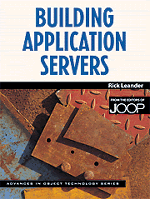Chapter 2 - Anatomy of an Application Server
from PART 1 - ARCHITECTURE
Published online by Cambridge University Press: 06 July 2010
Summary
According to the vendor literature, it appears that moving to multi-tiered client/server computing is as simple as buying a few products, creating a few Web pages, and writing a little bit of application code. In a recent Microsoft presentation, a company representative created a simple three-tiered application in less than ten minutes (Microsoft, Inc. 1998). He built a Web page with a couple extra lines of VBScript code, displayed about twenty lines of Visual Basic code that was already installed on the transaction server, and then with a few mouse clicks, showed how easy it was to validate a customer number. Too bad the transaction server code only returned “credit OK” if the customer number was 123456789.
Microsoft is not the only vendor using this approach to sell middleware products. Although the vendors make the development process look easy, these products are complex pieces of software. Just learning the programming conventions and protocols can take weeks, while producing industrial-strength code could take months. Tools like the Microsoft Transaction Server can make programming somewhat easier for developers by providing communications protocols and development frameworks, but even the simplest service will take far more than twenty lines of code.
This chapter will examine the application server from an architectural viewpoint and will also examine the major categories of middleware software. Topics will include:
Overview of the application server architecture
Middleware—the glue that holds it together
Middleware categories
Applying middleware to the application server architecture
Alternative application server architectures
Putting it all together
- Type
- Chapter
- Information
- Building Application Servers , pp. 15 - 40Publisher: Cambridge University PressPrint publication year: 2000



